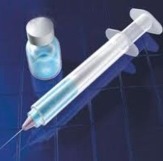|
Vaccines have proven to be one of the most important means for preventing
morbidity and mortality from infectious diseases worldwide. In the ED, the prevention
of infectious complications of wounds or bites is a high priority. In particular,
tetanus toxoid and rabies vaccination are routinely administered. Guidelines for
their use are summarized below.
| Guidelines for the routine use of tetanus prophylaxis in the U.S. |
|---|
| Simple and Uncomplicated Wounds | All Other Wounds |
Vaccinated
Unvaccinated
(unknown vaccination
or < 3 doses)
| Td 0.5 ml IM q 10 yr
Td 0.5 ml IM now
and 2 later doses
| Td 0.5 ml IM q 5 yr
Td 0.5 ml IM now
and 2 later doses
TIG 250 units IM |
| Including, but not limited to, burns, puncture wounds, avulsions, crush injuries, and
wounds contaminated with soil, saliva or feces. If 3 doses of "fluid toxoid" were given,
then a fourth dose of tetanus toxoid should be given, preferably the "absorbed toxoid". |
| Guidelines for post-exposure treatment for rabies |
|---|

| Animal Type | Recommendations |
| Dog, cat, ferret | Observe for 10 days if animal is healthy
-hold PET
Suspect rabid animal
-begin PET
Unknown (animal escaped)
-contact public health officials |
Raccoon, bat, skunk, fox,
coyote, other carnivores | Suspect rabid animal
-begin PET
(unless animal is available and tests negative) |
Large rodents (beavers and woodchucks),
Small rodents (chipmunks, squirrels, etc),
livestock, and other mammals | Consider each case individually
-contact public health officers |
| Post-exposure treatment |
Tetanus
- A primary vaccination series includes three doses providing protective antibodies in
more than 95% of recipients. It is recommended for children over 7 yr of age and
adults. For children < 7 yr the vaccination series begins at 2 mo of age and includes 5
doses. The diphtheria toxoid, tetanus toxoid, and either whole-cell or acellular pertussis
vaccine adsorbed (DTP or DTaP) are recommended. Patients older than 7 yr should
receive the adsorbed tetanus and diphtheria toxoids (Td).
Rabies
- Rabies is a viral illness transmitted by the contaminated saliva of an infected animal. It
causes progressive and inevitably fatal encephalitis. Fortunately, it is uncommon in the
United States. Only 36 human cases of rabies have been reported between 1980 and
1996.
- Rabies post-exposure treatment is recommended for persons exposed (i.e., bites,
scratches or mucous membrane contact) to bats unless the bat is available for immediate
testing and is found to be negative for rabies. Coyotes, foxes, raccoons, skunks, and
large rodents (beavers and woodchucks) are often infected with rabies and post-exposure
treatment is recommended for exposures associated with these animals. Small rodents
(squirrels, hamsters, guinea pigs, gerbils, chipmunks, rats and mice) and lagomorphs
(hares and rabbits) are rarely found infected with rabies and have not been known to
transmit the disease to humans. Domestic dogs, cats, and ferrets are infrequently infected
with rabies and the likelihood varies by geographic region. If the animal is
healthy it may be confined and observed for 10 days. If the animal becomes ill it must
be euthanized, its neural tissue examined for infection, and if present, post-exposure
treatment begun. If the animal remains well, then no treatment is warranted. State
and local health departments should be consulted for uncertain cases, those involving
small rodents, and cases where treatment is begun.
- All wounds potentially exposed to rabies must be aggressively and thoroughly cleaned
and irrigated.
- Patients suspected of being exposed to a rabid animal should begin post-exposure
treatment immediately. If a patient delays seeking evaluation, treatment should not be
withheld, because incubation periods >1 yr have been reported.
- The recommendation for previously unvaccinated individuals is a regimen of rabies
immune globulin (RIG) 20 IU/kg and a series of rabies vaccines, 1.0 ml IM in the
deltoid area, to be given on day 0, 3, 7, 14, and 28. If anatomically feasible, the full
dose of RIG should be infiltrated around the wound, with the remainder given IM at
another anatomical site distant from the wound and the vaccine site. If the patient is
previously vaccinated, then RIG is not given, and the passive vaccine is administered,
1.0 ml IM in the deltoid area, on days 0 and 3 only.
|